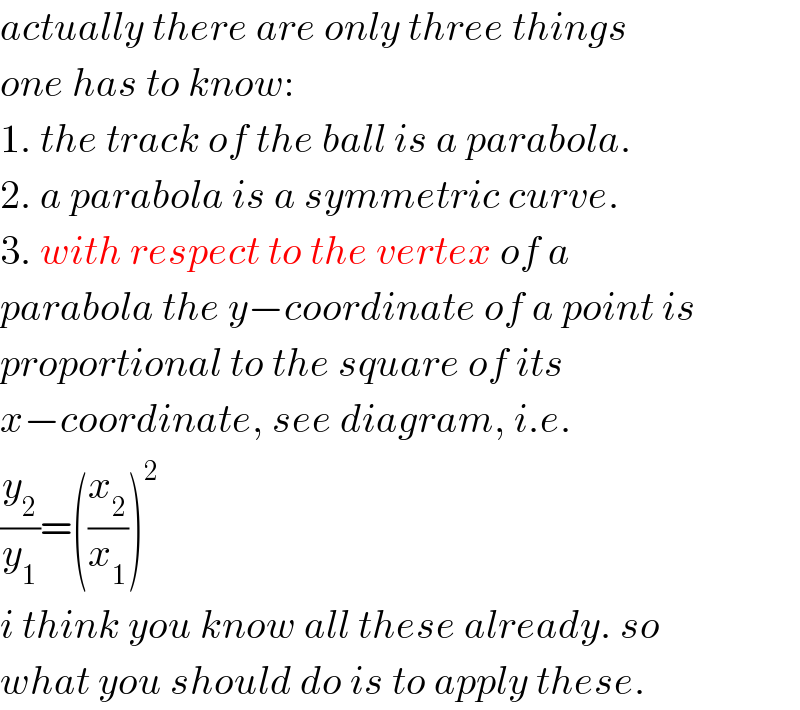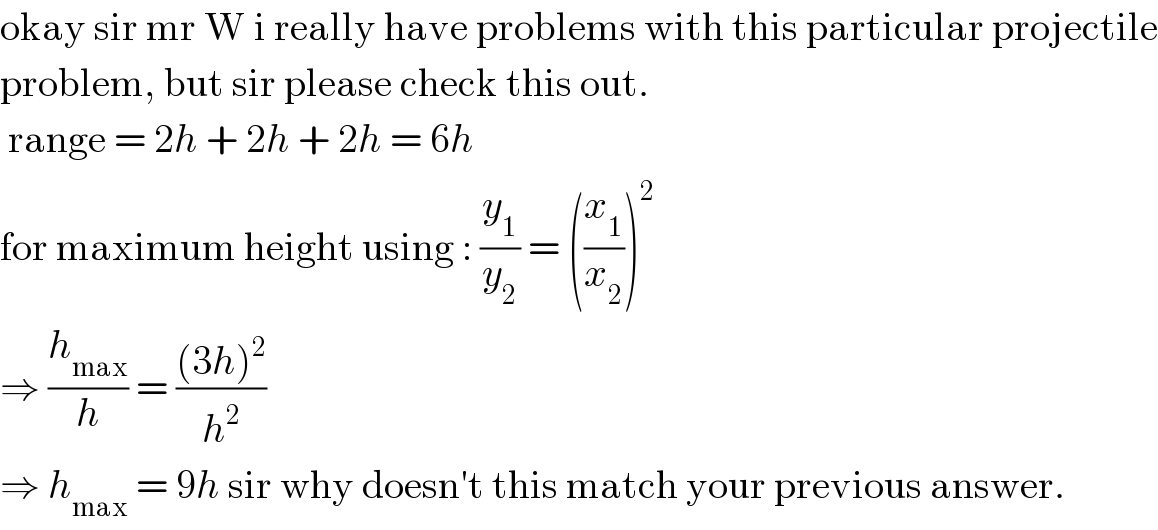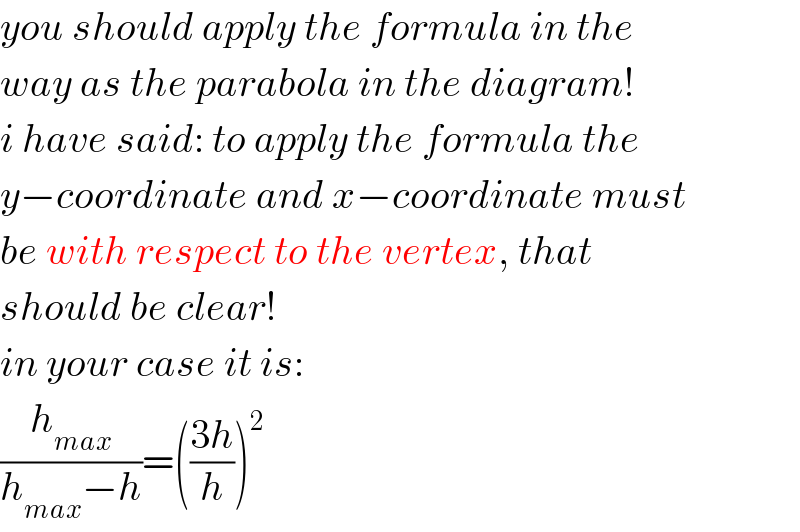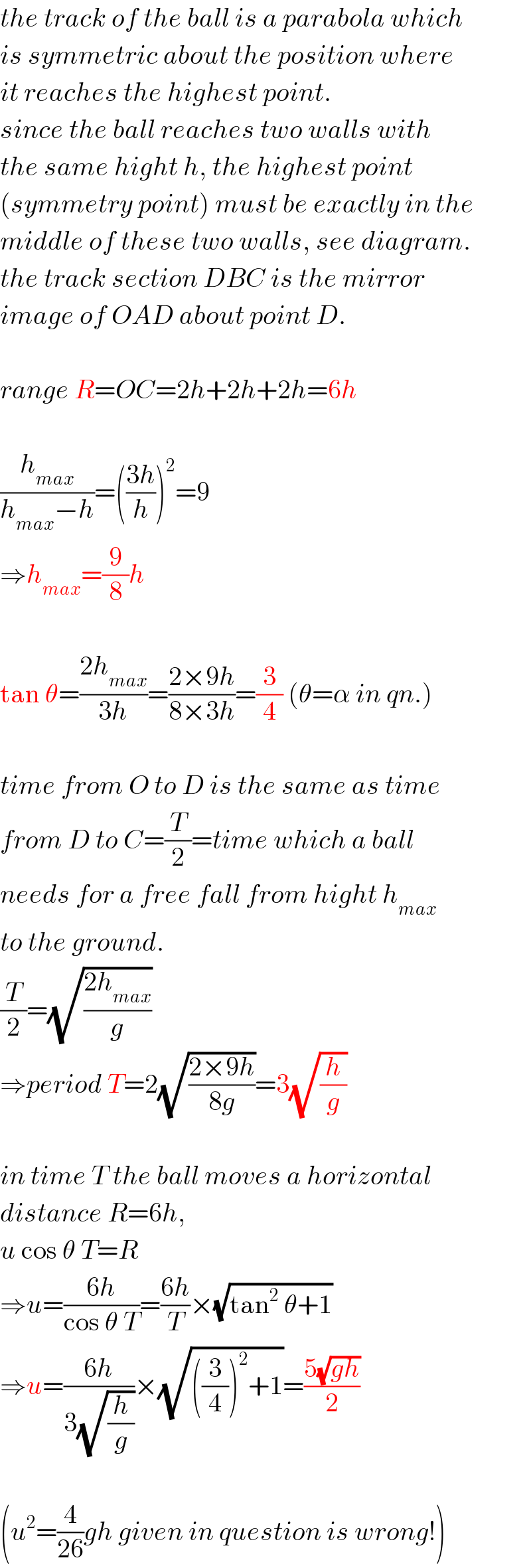
Question Number 91655 by Rio Michael last updated on 02/May/20

$$\mathrm{A}\:\mathrm{particle}\:\mathrm{is}\:\mathrm{projected}\:\mathrm{with}\:\mathrm{an}\:\mathrm{intial}\:\mathrm{velocity}\:\mathrm{of}\:{u}\:\mathrm{ms}^{−\mathrm{1}} \:\mathrm{at}\:\mathrm{an}\:\mathrm{angle}\:\alpha\:\mathrm{to}\: \\ $$$$\mathrm{the}\:\mathrm{ground}\:\mathrm{from}\:\mathrm{a}\:\mathrm{point}\:\mathrm{O}\:\mathrm{on}\:\mathrm{the}\:\mathrm{ground}.\:\mathrm{Given}\:\mathrm{that}\:\mathrm{it}\:\mathrm{clears} \\ $$$$\mathrm{two}\:\mathrm{walls}\:\mathrm{of}\:\mathrm{hieght}\:{h}\:\mathrm{and}\:\mathrm{distances}\:\mathrm{2h}\:\mathrm{and}\:\mathrm{4h}\:\mathrm{respectively}\:\mathrm{from}\:\mathrm{O}. \\ $$$$\left(\mathrm{a}\right)\:\mathrm{find}\:\mathrm{the}\:\mathrm{tangent}\:\mathrm{of}\:\alpha \\ $$$$\left(\mathrm{b}\right)\:\mathrm{the}\:\mathrm{maximum}\:\mathrm{hieght} \\ $$$$\left(\mathrm{c}\right)\:\mathrm{the}\:\mathrm{range}\:\mathrm{and}\:\mathrm{period}\:\mathrm{of}\:\mathrm{the}\:\mathrm{particle} \\ $$$$\left(\mathrm{d}\right)\:\mathrm{show}\:\mathrm{that}\:{u}^{\mathrm{2}} \:=\:\frac{\mathrm{4}}{\mathrm{26}}\:\mathrm{g}{h}\: \\ $$$$\mathrm{please}\:\mathrm{sir}\:\mathrm{can}\:\mathrm{you}\:\mathrm{help}\:\mathrm{me}\:\mathrm{using}\:\mathrm{the}\:\mathrm{actual}\:\mathrm{equations}\:\mathrm{of}\:\mathrm{projectile}\:\mathrm{motion}? \\ $$$$ \\ $$
Commented by Rio Michael last updated on 02/May/20

$$\mathrm{no}\:\mathrm{sir},\:\mathrm{not}\:\mathrm{clear},\:\mathrm{i}\:\mathrm{still}\:\mathrm{have}\:\mathrm{difficulties}\:\mathrm{solving} \\ $$$$\mathrm{the}\:\mathrm{problem}\:\mathrm{using}\:\mathrm{your}\:\mathrm{method}. \\ $$
Commented by mr W last updated on 02/May/20

$${i}\:{thought}\:{all}\:{is}\:{clear}\:{in}\:{Q}\mathrm{89319}. \\ $$
Commented by mr W last updated on 03/May/20

$${actually}\:{there}\:{are}\:{only}\:{three}\:{things} \\ $$$${one}\:{has}\:{to}\:{know}: \\ $$$$\mathrm{1}.\:{the}\:{track}\:{of}\:{the}\:{ball}\:{is}\:{a}\:{parabola}. \\ $$$$\mathrm{2}.\:{a}\:{parabola}\:{is}\:{a}\:{symmetric}\:{curve}. \\ $$$$\mathrm{3}.\:{with}\:{respect}\:{to}\:{the}\:{vertex}\:{of}\:{a} \\ $$$${parabola}\:{the}\:{y}−{coordinate}\:{of}\:{a}\:{point}\:{is}\: \\ $$$${proportional}\:{to}\:{the}\:{square}\:{of}\:{its} \\ $$$${x}−{coordinate},\:{see}\:{diagram},\:{i}.{e}. \\ $$$$\frac{{y}_{\mathrm{2}} }{{y}_{\mathrm{1}} }=\left(\frac{{x}_{\mathrm{2}} }{{x}_{\mathrm{1}} }\right)^{\mathrm{2}} \\ $$$${i}\:{think}\:{you}\:{know}\:{all}\:{these}\:{already}.\:{so} \\ $$$${what}\:{you}\:{should}\:{do}\:{is}\:{to}\:{apply}\:{these}. \\ $$
Commented by mr W last updated on 02/May/20

Commented by Rio Michael last updated on 02/May/20

$$\mathrm{thank}\:\mathrm{you}\:\mathrm{sir} \\ $$
Commented by Rio Michael last updated on 02/May/20

$$\mathrm{okay}\:\mathrm{sir}\:\mathrm{mr}\:\mathrm{W}\:\mathrm{i}\:\mathrm{really}\:\mathrm{have}\:\mathrm{problems}\:\mathrm{with}\:\mathrm{this}\:\mathrm{particular}\:\mathrm{projectile} \\ $$$$\mathrm{problem},\:\mathrm{but}\:\mathrm{sir}\:\mathrm{please}\:\mathrm{check}\:\mathrm{this}\:\mathrm{out}. \\ $$$$\:\mathrm{range}\:=\:\mathrm{2}{h}\:+\:\mathrm{2}{h}\:+\:\mathrm{2}{h}\:=\:\mathrm{6}{h} \\ $$$$\mathrm{for}\:\mathrm{maximum}\:\mathrm{height}\:\mathrm{using}\::\:\frac{{y}_{\mathrm{1}} }{{y}_{\mathrm{2}} }\:=\:\left(\frac{{x}_{\mathrm{1}} }{{x}_{\mathrm{2}} }\right)^{\mathrm{2}} \\ $$$$\Rightarrow\:\frac{{h}_{\mathrm{max}} }{{h}}\:=\:\frac{\left(\mathrm{3}{h}\right)^{\mathrm{2}} }{{h}^{\mathrm{2}} } \\ $$$$\Rightarrow\:{h}_{\mathrm{max}} \:=\:\mathrm{9}{h}\:\mathrm{sir}\:\mathrm{why}\:\mathrm{doesn}'\mathrm{t}\:\mathrm{this}\:\mathrm{match}\:\mathrm{your}\:\mathrm{previous}\:\mathrm{answer}. \\ $$
Commented by mr W last updated on 02/May/20

$${you}\:{should}\:{apply}\:{the}\:{formula}\:{in}\:{the} \\ $$$${way}\:{as}\:{the}\:{parabola}\:{in}\:{the}\:{diagram}! \\ $$$${i}\:{have}\:{said}:\:{to}\:{apply}\:{the}\:{formula}\:{the} \\ $$$${y}−{coordinate}\:{and}\:{x}−{coordinate}\:{must} \\ $$$${be}\:{with}\:{respect}\:{to}\:{the}\:{vertex},\:{that} \\ $$$${should}\:{be}\:{clear}! \\ $$$${in}\:{your}\:{case}\:{it}\:{is}: \\ $$$$\frac{{h}_{{max}} }{{h}_{{max}} −{h}}=\left(\frac{\mathrm{3}{h}}{{h}}\right)^{\mathrm{2}} \\ $$
Commented by mr W last updated on 02/May/20

Commented by mr W last updated on 02/May/20

Commented by Rio Michael last updated on 02/May/20

$$\mathrm{oh}\:\mathrm{thank}\:\mathrm{God}\:\mathrm{sir}\:\mathrm{i}\:\mathrm{finally}\:\mathrm{got}\:\mathrm{it}\:\mathrm{thanks} \\ $$
Commented by mr W last updated on 02/May/20

$${never}\:{just}\:{apply}\:{a}\:{formula}\:{before} \\ $$$${one}\:{has}\:{understood}\:{it}! \\ $$
Commented by Rio Michael last updated on 02/May/20

$$\mathrm{okay}\:\mathrm{sir}\:\mathrm{thanks} \\ $$
Answered by mr W last updated on 03/May/20

$$\boldsymbol{{Method}}\:\boldsymbol{{I}}\:\left({quick}\:{and}\:{safe},\:{but}\:{one}\right. \\ $$$${should}\:{have}\:{deep}\:{understanding}\:{about} \\ $$$${projectile}\:{motion}\:{and}\:{the}\:{features} \\ $$$$\left.{of}\:{parabola}\right) \\ $$
Commented by mr W last updated on 03/May/20

Commented by mr W last updated on 03/May/20

$${the}\:{track}\:{of}\:{the}\:{ball}\:{is}\:{a}\:{parabola}\:{which} \\ $$$${is}\:{symmetric}\:{about}\:{the}\:{position}\:{where} \\ $$$${it}\:{reaches}\:{the}\:{highest}\:{point}. \\ $$$${since}\:{the}\:{ball}\:{reaches}\:{two}\:{walls}\:{with} \\ $$$${the}\:{same}\:{hight}\:{h},\:{the}\:{highest}\:{point} \\ $$$$\left({symmetry}\:{point}\right)\:{must}\:{be}\:{exactly}\:{in}\:{the} \\ $$$${middle}\:{of}\:{these}\:{two}\:{walls},\:{see}\:{diagram}. \\ $$$${the}\:{track}\:{section}\:{DBC}\:{is}\:{the}\:{mirror} \\ $$$${image}\:{of}\:{OAD}\:{about}\:{point}\:{D}. \\ $$$$ \\ $$$${range}\:{R}={OC}=\mathrm{2}{h}+\mathrm{2}{h}+\mathrm{2}{h}=\mathrm{6}{h} \\ $$$$ \\ $$$$\frac{{h}_{{max}} }{{h}_{{max}} −{h}}=\left(\frac{\mathrm{3}{h}}{{h}}\right)^{\mathrm{2}} =\mathrm{9} \\ $$$$\Rightarrow{h}_{{max}} =\frac{\mathrm{9}}{\mathrm{8}}{h} \\ $$$$ \\ $$$$\mathrm{tan}\:\theta=\frac{\mathrm{2}{h}_{{max}} }{\mathrm{3}{h}}=\frac{\mathrm{2}×\mathrm{9}{h}}{\mathrm{8}×\mathrm{3}{h}}=\frac{\mathrm{3}}{\mathrm{4}}\:\left(\theta=\alpha\:{in}\:{qn}.\right) \\ $$$$ \\ $$$${time}\:{from}\:{O}\:{to}\:{D}\:{is}\:{the}\:{same}\:{as}\:{time} \\ $$$${from}\:{D}\:{to}\:{C}=\frac{{T}}{\mathrm{2}}={time}\:{which}\:{a}\:{ball} \\ $$$${needs}\:{for}\:{a}\:{free}\:{fall}\:{from}\:{hight}\:{h}_{{max}} \\ $$$${to}\:{the}\:{ground}. \\ $$$$\frac{{T}}{\mathrm{2}}=\sqrt{\frac{\mathrm{2}{h}_{{max}} }{{g}}} \\ $$$$\Rightarrow{period}\:{T}=\mathrm{2}\sqrt{\frac{\mathrm{2}×\mathrm{9}{h}}{\mathrm{8}{g}}}=\mathrm{3}\sqrt{\frac{{h}}{{g}}} \\ $$$$ \\ $$$${in}\:{time}\:{T}\:{the}\:{ball}\:{moves}\:{a}\:{horizontal} \\ $$$${distance}\:{R}=\mathrm{6}{h}, \\ $$$${u}\:\mathrm{cos}\:\theta\:{T}={R} \\ $$$$\Rightarrow{u}=\frac{\mathrm{6}{h}}{\mathrm{cos}\:\theta\:{T}}=\frac{\mathrm{6}{h}}{{T}}×\sqrt{\mathrm{tan}^{\mathrm{2}} \:\theta+\mathrm{1}} \\ $$$$\Rightarrow{u}=\frac{\mathrm{6}{h}}{\mathrm{3}\sqrt{\frac{{h}}{{g}}}}×\sqrt{\left(\frac{\mathrm{3}}{\mathrm{4}}\right)^{\mathrm{2}} +\mathrm{1}}=\frac{\mathrm{5}\sqrt{{gh}}}{\mathrm{2}} \\ $$$$ \\ $$$$\left({u}^{\mathrm{2}} =\frac{\mathrm{4}}{\mathrm{26}}{gh}\:{given}\:{in}\:{question}\:{is}\:{wrong}!\right) \\ $$
Commented by Rio Michael last updated on 03/May/20

$$\mathrm{wow}\:\mathrm{sir}\:\mathrm{thanks}\:\mathrm{so}\:\mathrm{much}\:\mathrm{again}.\:\mathrm{I}\:\mathrm{don}'\mathrm{t}\:\mathrm{know}\:\mathrm{why} \\ $$$$\mathrm{this}\:\mathrm{particular}\:\mathrm{projectile}\:\mathrm{motion}\:\mathrm{problem}\:\mathrm{dealt}\:\mathrm{with}\: \\ $$$$\mathrm{my}\:\mathrm{understanding}.\:\mathrm{Guess}\:\mathrm{i}\:\mathrm{have}\:\mathrm{to}\:\mathrm{take}\:\mathrm{a}\:\mathrm{whole}\:\mathrm{course} \\ $$$$\mathrm{on}\:\mathrm{this}\:\mathrm{again}\:,\mathrm{including}\:\mathrm{parabolic}\:\mathrm{paths}. \\ $$
Answered by mr W last updated on 03/May/20

$$\boldsymbol{{Method}}\:\boldsymbol{{II}}\:\left({what}\:{maybe}\:{the}\:{most}\right. \\ $$$$\left.{people}\:{do}\right) \\ $$
Commented by mr W last updated on 03/May/20

Commented by mr W last updated on 03/May/20
/g)−(h/(u cos θ)))=h (u sin θ +((gh)/(u cos θ)))(u sin θ−((gh)/(u cos θ)))=2gh u^2 sin^2 θ−((g^2 h^2 )/(u^2 cos^2 θ))=2gh (u^2 sin θ cos θ)^2 −g^2 h^2 =2ghu^2 cos^2 θ 9g^2 h^2 −g^2 h^2 =2ghu^2 cos^2 θ 4gh=u^2 cos^2 θ ⇒u cos θ=2(√(gh)) ⇒u sin θ=((3(√(gh)))/2) ⇒tan θ=(3/4) h_(max) at t=t_1 : u sin θ−gt_1 =0 t_1 =((u sin θ)/g)=((3(√(gh)))/(2g))=(3/2)(√(h/g)) h_(max) =u sin θ t_1 −(1/2)gt_1 ^2 =((3(√(gh)))/2)×(3/2)(√(h/g))−(1/2)g×(9/4)×(h/g) =((9h)/4)−((9h)/8)=((9h)/8) range at t=T (=period): u sin θ T−(1/2)gT^2 =0 ⇒T=((2 u sin θ)/g)=(2/g)×((3(√(gh)))/2)=3(√(h/g)) range R=u cos θ T=2(√(gh))×3(√(h/g))=6h u^2 =((3gh)/(sin θ cos θ))=((3gh)/((3/5)×(4/5)))=((25gh)/4)](Q91865.png)
$${x}={u}\:\mathrm{cos}\:\theta\:{t} \\ $$$${y}={u}\:\mathrm{sin}\:\theta\:{t}−\frac{\mathrm{1}}{\mathrm{2}}{gt}^{\mathrm{2}} \\ $$$${x}_{{A}} ={u}\:\mathrm{cos}\:\theta\:{t}_{{A}} =\mathrm{2}{h} \\ $$$${y}_{{A}} ={u}\:\mathrm{sin}\:\theta\:{t}_{{A}} −\frac{\mathrm{1}}{\mathrm{2}}{gt}_{{A}} ^{\mathrm{2}} ={h} \\ $$$${x}_{{B}} ={u}\:\mathrm{cos}\:\theta\:{t}_{{B}} =\mathrm{4}{h} \\ $$$${y}_{{B}} ={u}\:\mathrm{sin}\:\theta\:{t}_{{B}} −\frac{\mathrm{1}}{\mathrm{2}}{gt}_{{B}} ^{\mathrm{2}} ={h} \\ $$$${x}_{{B}} −{x}_{{A}} ={u}\:\mathrm{cos}\:\theta\:\left({t}_{{B}} −{t}_{{A}} \right)=\mathrm{4}{h}−\mathrm{2}{h}=\mathrm{2}{h} \\ $$$$\Rightarrow{t}_{{B}} −{t}_{{A}} =\frac{\mathrm{2}{h}}{{u}\:\mathrm{cos}\:\theta} \\ $$$${y}_{{B}} −{y}_{{B}} ={u}\:\mathrm{sin}\:\theta\:\left({t}_{{B}} −{t}_{{A}} \right)−\frac{\mathrm{1}}{\mathrm{2}}{g}\left({t}_{{B}} ^{\mathrm{2}} −{t}_{{A}} ^{\mathrm{2}} \right)={h}−{h}=\mathrm{0} \\ $$$${u}\:\mathrm{sin}\:\theta−\frac{\mathrm{1}}{\mathrm{2}}{g}\left({t}_{{B}} +{t}_{{A}} \right)=\mathrm{0} \\ $$$$\Rightarrow{t}_{{B}} +{t}_{{A}} =\frac{\mathrm{2}{u}\:\mathrm{sin}\:\theta}{{g}} \\ $$$$\mathrm{2}{t}_{{A}} =\frac{\mathrm{2}{u}\:\mathrm{sin}\:\theta}{{g}}−\frac{\mathrm{2}{h}}{{u}\:\mathrm{cos}\:\theta} \\ $$$$\Rightarrow{t}_{{A}} =\frac{{u}\:\mathrm{sin}\:\theta}{{g}}−\frac{{h}}{{u}\:\mathrm{cos}\:\theta} \\ $$$${u}\:\mathrm{cos}\:\theta\:\left(\frac{{u}\:\mathrm{sin}\:\theta}{{g}}−\frac{{h}}{{u}\:\mathrm{cos}\:\theta}\right)=\mathrm{2}{h} \\ $$$$\Rightarrow{u}^{\mathrm{2}} \mathrm{sin}\:\theta\:\mathrm{cos}\:\theta=\mathrm{3}{gh} \\ $$$$\left({u}\:\mathrm{sin}\:\theta\:−\frac{\mathrm{1}}{\mathrm{2}}{gt}_{{A}} \right){t}_{{A}} ={h} \\ $$$$\left[{u}\:\mathrm{sin}\:\theta\:−\frac{\mathrm{1}}{\mathrm{2}}{g}\left(\frac{{u}\:\mathrm{sin}\:\theta}{{g}}−\frac{{h}}{{u}\:\mathrm{cos}\:\theta}\right)\right]\left(\frac{{u}\:\mathrm{sin}\:\theta}{{g}}−\frac{{h}}{{u}\:\mathrm{cos}\:\theta}\right)={h} \\ $$$$\left({u}\:\mathrm{sin}\:\theta\:+\frac{{gh}}{{u}\:\mathrm{cos}\:\theta}\right)\left({u}\:\mathrm{sin}\:\theta−\frac{{gh}}{{u}\:\mathrm{cos}\:\theta}\right)=\mathrm{2}{gh} \\ $$$${u}^{\mathrm{2}} \mathrm{sin}^{\mathrm{2}} \:\theta−\frac{{g}^{\mathrm{2}} {h}^{\mathrm{2}} }{{u}^{\mathrm{2}} \mathrm{cos}^{\mathrm{2}} \:\theta}=\mathrm{2}{gh} \\ $$$$\left({u}^{\mathrm{2}} \mathrm{sin}\:\theta\:\mathrm{cos}\:\theta\right)^{\mathrm{2}} −{g}^{\mathrm{2}} {h}^{\mathrm{2}} =\mathrm{2}{ghu}^{\mathrm{2}} \mathrm{cos}^{\mathrm{2}} \:\theta \\ $$$$\mathrm{9}{g}^{\mathrm{2}} {h}^{\mathrm{2}} −{g}^{\mathrm{2}} {h}^{\mathrm{2}} =\mathrm{2}{ghu}^{\mathrm{2}} \mathrm{cos}^{\mathrm{2}} \:\theta \\ $$$$\mathrm{4}{gh}={u}^{\mathrm{2}} \mathrm{cos}^{\mathrm{2}} \:\theta \\ $$$$\Rightarrow{u}\:\mathrm{cos}\:\theta=\mathrm{2}\sqrt{{gh}} \\ $$$$\Rightarrow{u}\:\mathrm{sin}\:\theta=\frac{\mathrm{3}\sqrt{{gh}}}{\mathrm{2}} \\ $$$$\Rightarrow\mathrm{tan}\:\theta=\frac{\mathrm{3}}{\mathrm{4}} \\ $$$$ \\ $$$${h}_{{max}} \:{at}\:{t}={t}_{\mathrm{1}} : \\ $$$${u}\:\mathrm{sin}\:\theta−{gt}_{\mathrm{1}} =\mathrm{0} \\ $$$${t}_{\mathrm{1}} =\frac{{u}\:\mathrm{sin}\:\theta}{{g}}=\frac{\mathrm{3}\sqrt{{gh}}}{\mathrm{2}{g}}=\frac{\mathrm{3}}{\mathrm{2}}\sqrt{\frac{{h}}{{g}}} \\ $$$${h}_{{max}} ={u}\:\mathrm{sin}\:\theta\:{t}_{\mathrm{1}} −\frac{\mathrm{1}}{\mathrm{2}}{gt}_{\mathrm{1}} ^{\mathrm{2}} =\frac{\mathrm{3}\sqrt{{gh}}}{\mathrm{2}}×\frac{\mathrm{3}}{\mathrm{2}}\sqrt{\frac{{h}}{{g}}}−\frac{\mathrm{1}}{\mathrm{2}}{g}×\frac{\mathrm{9}}{\mathrm{4}}×\frac{{h}}{{g}} \\ $$$$=\frac{\mathrm{9}{h}}{\mathrm{4}}−\frac{\mathrm{9}{h}}{\mathrm{8}}=\frac{\mathrm{9}{h}}{\mathrm{8}} \\ $$$$ \\ $$$${range}\:{at}\:{t}={T}\:\left(={period}\right): \\ $$$${u}\:\mathrm{sin}\:\theta\:{T}−\frac{\mathrm{1}}{\mathrm{2}}{gT}^{\mathrm{2}} =\mathrm{0} \\ $$$$\Rightarrow{T}=\frac{\mathrm{2}\:{u}\:\mathrm{sin}\:\theta}{{g}}=\frac{\mathrm{2}}{{g}}×\frac{\mathrm{3}\sqrt{{gh}}}{\mathrm{2}}=\mathrm{3}\sqrt{\frac{{h}}{{g}}} \\ $$$${range}\:{R}={u}\:\mathrm{cos}\:\theta\:{T}=\mathrm{2}\sqrt{{gh}}×\mathrm{3}\sqrt{\frac{{h}}{{g}}}=\mathrm{6}{h} \\ $$$$ \\ $$$${u}^{\mathrm{2}} =\frac{\mathrm{3}{gh}}{\mathrm{sin}\:\theta\:\mathrm{cos}\:\theta}=\frac{\mathrm{3}{gh}}{\frac{\mathrm{3}}{\mathrm{5}}×\frac{\mathrm{4}}{\mathrm{5}}}=\frac{\mathrm{25}{gh}}{\mathrm{4}} \\ $$
Commented by mr W last updated on 03/May/20

$${we}\:{get}\:{exactly}\:{the}\:{same}\:{results}\:{as}\:{with} \\ $$$${method}\:{I}. \\ $$
Commented by Rio Michael last updated on 03/May/20

$$\mathrm{wow}\:\mathrm{sir}\:\mathrm{thank}\:\mathrm{you}\:\mathrm{so}\:\mathrm{much}\:\mathrm{for}\:\mathrm{you}\:\mathrm{effort} \\ $$$$\mathrm{in}\:\mathrm{making}\:\mathrm{me}\:\mathrm{understand}\:\mathrm{this}\:\mathrm{particular}\:\mathrm{problem} \\ $$$$\mathrm{you}\:\mathrm{are}\:\mathrm{such}\:\mathrm{a}\:\mathrm{God}'\mathrm{s}\:\mathrm{send}.\:\mathrm{thank}\:\mathrm{you}\:\mathrm{so}\:\mathrm{much}\:\mathrm{sir}. \\ $$$$\mathrm{am}\:\mathrm{100\%}\:\mathrm{sure}\:\mathrm{to}\:\mathrm{solve}\:\mathrm{any}\:\mathrm{projectile}\:\mathrm{problem}\:\mathrm{like}\:\mathrm{this}. \\ $$
